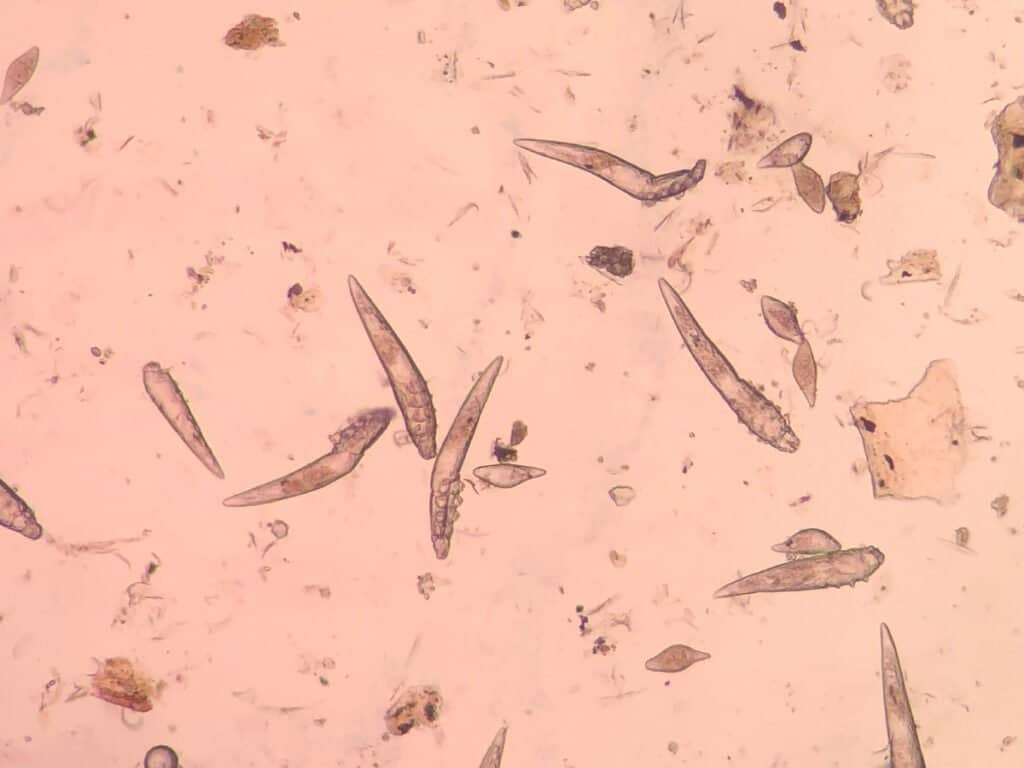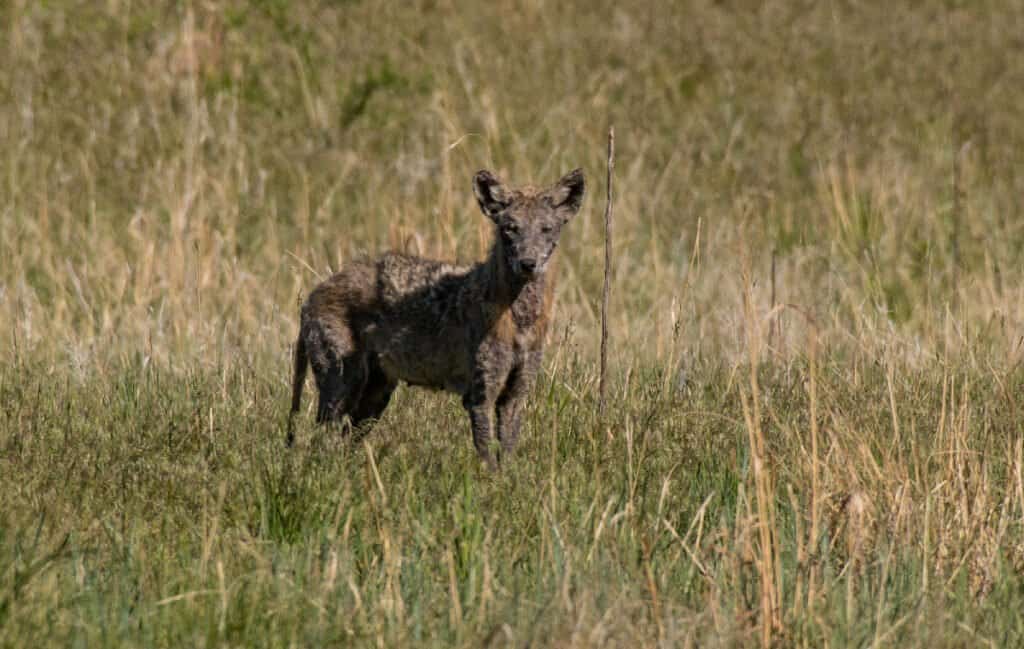Coyotes and their cousins are susceptible to the devastating condition known as mange, or Sarcoptes scabiei. Coyotes get mange from a mite that burrows under the skin. A coyote with mange may exhibit unusual behavior. Though nocturnal, they are more likely to be seen during the day searching for food. They can’t hunt thus they require an easy meal.
What Does It Mean If A Coyote Has Mange?

Coyote With Mange
©Trevor Clark/Shutterstock.com
Sadly, it is common for mange-infected coyotes to scratch themselves so raw that excessive infection is commonly the result. Without proper treatment, these infections can cause fatality, especially in colder weather conditions.
Mange Symptoms In Coyotes:
Mange is a parasitic mite skin ailment that frequently results in:
- Severe itching
- Hair loss
- Scabs and ulcers on the skin
- Secondary Infections
- Death in extreme cases
How Do Coyotes Contract Mange?

Mange is a parasite that burrows into the skin of coyotes.
©wimala namket/Shutterstock.com
A mite that burrows into the skin of an infected host spreads the disease known as ‘mange.’ It’s not understood why some coyotes are more susceptible to this disease than others. However, mange in wild animals may be caused, in part, by rat poison, according to new research.
The theory is that poisoned rats can be eaten by predators including owls, foxes, hawks, domestic cats and dogs, and wild cats and dogs. As the rodent weakens from the poison, it can become easy prey for predators (like coyotes). When a coyote devours a poisoned mouse or rat, it too becomes poisoned.
Although more research is needed to confirm this link, experts are seeing results that show rat poisons can lead to severe mange in wild animals such as coyotes.
What To Do If You See A Coyote With Mange

Coyotes with mange should be avoided as mange is highly contagious.
©Kerry Hargrove/Shutterstock.com
It’s common to see mange-infected coyotes snoozing on sidewalks and street corners, as well as laying in the sun to warm themselves. Typically, these sick coyotes just want to survive and are not antagonistic in any way. However, even in this state, they’re difficult to capture and you should never attempt to approach an infected coyote or any infected animal. Mange is highly contagious.
Also, do not, under any circumstances, feed any wild coyotes, no matter how tempting it may seem. Research shows that feeding diseased animals just causes more problems for them.
How Can You Help?
It is tough to see animals with mange because of their awful condition, yet they can recover from the disease. In most cases, it’s preferable to leave the animals where they are and report the sighting to your state wildlife agency or to use the NWRA “Find a Rehabilitator” link to find wildlife rehabilitators in your area who can help.
There are a variety of other organizations you can turn to if you’re unable to track down a wildlife rehabilitator, such as your local vet, animal control agency, or humane society.
Try to document the following:
- Any photos (only if safe to do so)
- Address or sighting spot
- Time of day
- Date
Is Coyote Mange Contagious?

Coyote With Mange
©iStock.com/Gary Gray
Scabies and other forms of mange can be contracted by encountering the mites that cause the disease. In metropolitan settings, coyotes presumably function as the host for this virus, which can spread to pets and, rarely, people.
If you think you have encountered mange, be sure to wash your hands immediately. Mange symptoms may not appear for weeks following infestation. Contact your doctor right away if you think you have a form of mange. There may be symptoms of a mite infestation on your skin that your doctor will inspect for.
Mange symptoms in humans include:
- Severe, itchy rash
- Elevated, skin-colored, or grayish-white tracts
- Lumps or blisters on the surface of the skin
Mange is most likely to affect skin creases, including:
- Inner elbows
- Wrists
- Behind the knees
- Buttocks
- Bottom of the feet
- Shoulder blades
The correct medical therapies can quickly remove mange. However, left untreated, it might cause secondary infections making it more difficult to treat.
How Long Can A Coyote With Mange Survive?
Even though mange is highly uncomfortable, some coyotes can live with it for a few years. Harsh weather conditions and infections caused by exposed sores and intense itching are the most common causes of death for these animals. Once the illness and any secondary infections are irradicated, the coyote can live much longer richer lives.
Is Mange Curable In Coyotes?
The mites that cause mange can be eliminated by administering a specific medicine. Biologists, veterinarians, and other wildlife specialists are working together to discover novel drugs that can be used to treat animals with mange more effectively.
If there are secondary infections, those will need to be treated properly and as soon as possible. Sadly, it is extremely rare for coyotes to survive secondary infections.
Bonus: Why Do You See Coyotes Everywhere Now?

Coyotes have become a common sight in neighborhoods all over the country.
©Ajax9/Shutterstock.com
Not that long ago, a coyote was synonymous with the prairies and deserts of the great American West along with cowboys and wagon trains. Now, they are everywhere – in cities, neighborhoods, and land all across the United States. Coyotes thrive in urban areas because they take advantage of any little patch of habitat and they will eat anything – garbage, pet food – even pets themselves.
How have they expanded their range so quickly and thoroughly? Coyotes have been on the move since the 1800s – when European settlers transformed the native landscape through logging and agricultural development. This created more open habitats in eastern states – and the coyotes moved in as land opened up. This happened as humans attempted to exterminate wolves and cougars, which decreased competition for coyotes. They took advantage of every opportunity.
Coyotes are highly adaptable and seem to like golf courses and parks. They aren’t picky about where they sleep at night – often just sleeping out in the open or under a shrub in someone’s yard. Experts have no idea how many coyotes there are – estimates range from one to 10 million in North America. There are just too many to count with their number increasing.
The photo featured at the top of this post is © iStock.com/Gary Gray
Thank you for reading! Have some feedback for us? Contact the AZ Animals editorial team.







